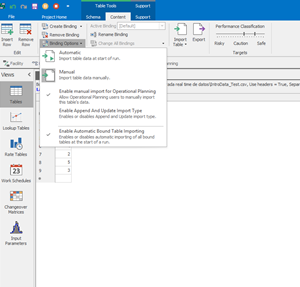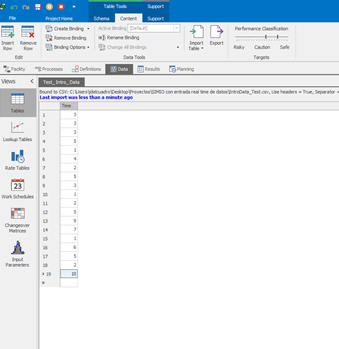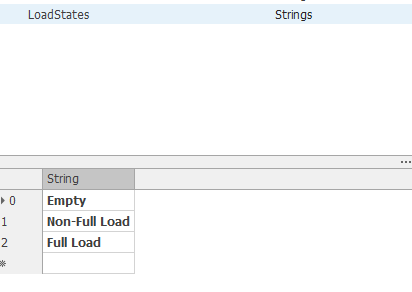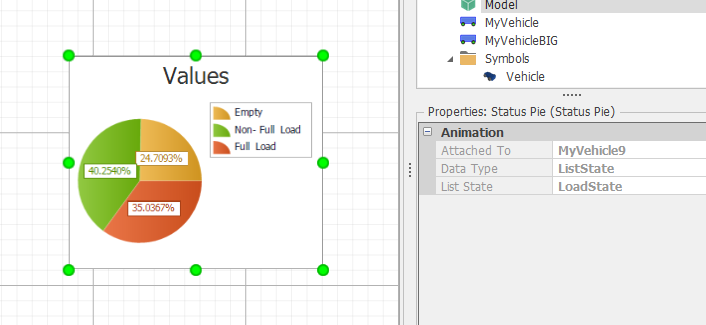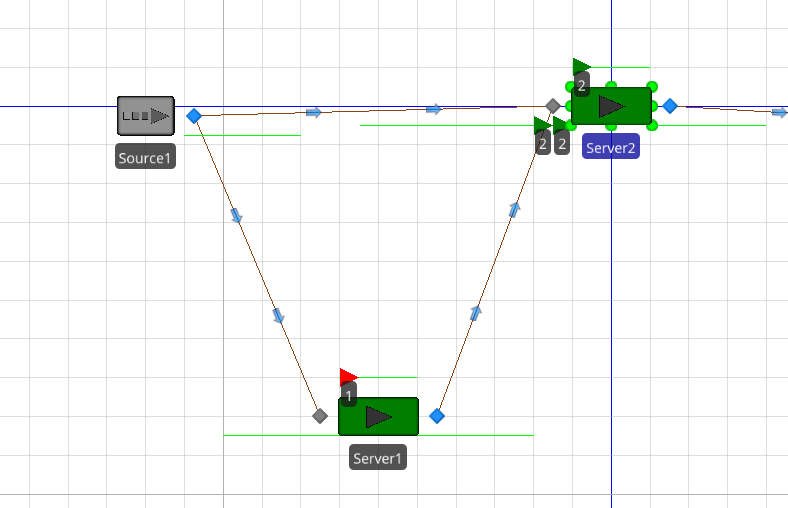Search the Community
Showing results for 'tally wait times'.
-
I'm making a simple simulation model of a hospital and I'm having trouble with the routing of my model. For instance, a patient first goes through ED and then to OR. if there is no room in the OR, then the patient must stay in ED. How can I model this? I don't want the patient to wait at any input or output buffer, because then it assumes that the ED bed that the patient used to stay in is now free but it actually isn't. Each bed is modeled as a server and there are more ED beds than there are OR beds. Naturally, all ED beds connect to a single transfer node, which then connect to all OR beds.
-
Hi again! Ok! I must've missed it because I tried to use it as a time table (for arrival times) , but now I've tried what you told me before with it as a State and it does update both the table and the simulation! (It takes values at random, but it works! I'll try to find a way to make a time index!) So I'll update my question! Can arrival time tables be modified the same way? Because it didn't work for me using the method we both described! It changed the units and got a bit fuzzy with it, like taking values at random instead of following the order of the table! Referencing the pictures above, it would be like it started following the arrival table in order (3,3,3,4,8,9...) and after I update it it just goes full random and takes whatever value it wants(making it quite hard to check if it actually used the new ones which it usually doesn't for some reason) , is there a way to keep the arrival times following an order after I update the table? Or am I doing something terribly wrong? (Which being honest, is much more likely! haha) Thanks to everyone in advance, and so sorry for my mistake!
-
Hi, I am using Simio V11 and try to implement the "Introduction to Simulation and Scheduling" Course where workstations are used with setup and teardown times. In Simio 10 (Sprint 187 - Final Version 10 Release) workstations were deprecated and it seems that they have been removed completely in V11. How should I implement the workstations from the course? Cheers, Ralf
-
Yes, I need to create a material based on the entities' arriving (each entity has a BOM ) and the entities have to wait in the node untill the production of the material (leather). It seems that the model can't see the process and it doesn't produce the material and it doesn't respect the lead time. Maybe there is a problem with the tokens and the varaibles' assignments.
-
My problem is that the set of workers should do a test on the patients and then clean the room and finish the final paper works. From the simulation, I want to see in what days of the week and what times of the day, the number of workers does not match the demand. (see in what window thought out the week workers are more busy and people experience more waiting time, or workers are less busy). I am thinking to define some states to save the total time which the worker where busy in a specific window. Or save the wait time of each patient in specific time windows. I want to have access to all the saved values at the end. For example if 1700 patients are generated and 500 of them are served in weekends; I want to see the waiting time of all those 500 patients in the weekends. So I am not looking for a single number. I am looking for some specific state values related to each patient or worker. And dependent on the definition of the state (which time frame it is focused on), I will save it in specific time frames. I am not sure how I can do that. Any help is really appreciated.
-
Hello, I have a network with one source and different sinks. I use add on process on the output of my source to choose the sinks based in the capacity. When I run the model, all created entities destroyed in the sinks correctly but in result part, "TimeInSystem" is equal zero. Due to add on process, is it happen?Should I calculate time in system with Tally? Best, Nadere
-
The New York City Health Department's Division of Disease Control is responsible for the identification, surveillance, treatment, control and prevention of infectious diseases in NYC. The Division is composed of seven bureaus and operates clinics across the city to provider sixual health services, tuberculosis diagnosis and treatment, and immunization. The Division is seeking one intern to assist us with a project at our clinics, with the goal on identifying new workflows to increase patient throughput and optimize resources. Duties and Responsibilities: Under supervision, the intern will perform a variety duties, including but not be limited to: Analyzing existing data that was used to measure cycle time/wait time Conducting time-motion studies to collect cycle/wait time data across clinics Analyzing clinical cycle/wait time data to identify efficiency and inefficiency Running simulations to identify changes to reduce visit cycle time Qualifications: Matriculation at an accredited college or graduate school. Employment is conditioned upon continuance as a student in a college or graduate school; Knowledge and experiences of discrete-event simulation method is highly preferred; Experiences of data collection, data entry and data analysis; An understanding of health equity issues within the context of infectious disease public health is also encouraged. Hours and Rate: 30-35 hours/week during the summer, or approximately 20 hours/week during the school year, flexible daytime and evening hours from 9am-5pm. The proposed salary range is $15.50 - $19.90 per hour. Residency Requirement: New York City residency is generally required within 90 days of appointment. However, City Employees in certain titles who have worked for the City for 2 continuous years may also be eligible to reside in Nassau, Suffolk, Putnam, Westchester, Rockland, or Orange County. To determine if the residency requirement applies to you, please discuss with the agency representative at the time of interview. Application: Please send your resume and personal statement to Dogan Kizilirmak @ <dkizilirmak@health.nyc.gov>, and feel free to reach out if you have any questions.
-
- internship
- operation research
-
(and 2 more)
Tagged with:
-
Hi Tom, thanks for your help! I've found a solution on my own in the meantime (probably not as sophisticated as yours but it works well). I additionally modelled a small version of the lift itself and created a wait process. The triggering event is "vehicle exits Node X". I used the process for my servers ("after processing"). So whenever a chair exits the node, the gates will open. This is actually quite close to reality where the gate opening interval is not fixed but depends on the speed of the lift and the point in time when an empty chair arrives. All the best, Nico
-
Hello and thanks for reading, I'm building a model that should replicate how vessels are handled within a port area. Within this area, there are multiple Terminals (servers) and ships (entities) that have to visit any number of terminals. Their processing times at each server vary. With their sequences predefined, I have managed to model this accurately, based on a first come first serve or another dispatching rule. I'd like to implement a dynamic sequence. 1) How can I model a certain degree of freedom in their sequences - e.g. a vessel is free to choose between sequence XABZ or XBAZ, depending on the queue size at A or B at the time of leaving X? However, in reality, these vessels enter the system, draft a sequence that is suitable for their loading plan, and then try to reserve serving times at the various terminals. I have tried wrapping my head around ways to model this, but can't seem to think of a way how. I could create a large amount of state variables for each server, that denotes whether or not a certain slot has been reserved, but that is not suitable for running long simulations. I read on this forum post that I could perhaps use a storage element, and store the reservations in there. How would I go about saving reservation-related information? Should I store that on the barge entity or in the terminal's reservation storage? How should I go about modelling timeslots in itself? 2) How can I model 'future' reservations of entities at the various servers? Finally, if this functions properly, and entities can request reservations at the various servers, I would like to have the servers compare all the requests at a certain cutoff time, and for all the doubly requested slots have it allocate the reservation based on the entities' characteristics. 3) Would I have to store the reservation data on both the entity and the server side for them to both make calculations with them, or is it enough to have them all on the server side, and denote whether they have been accepted with e.g. a boolean property? My apologies for the long post. Do not hesitate to ask for more information. Kind regards, Tom
-
2) How can I extract the total amount of times or distances that a vehicle is traveling empty (without load)? you should subclass the vehicle and create a list containing all the loadstus(string) and in its process logic( like OnRiderLoaded, RideStation.Exited....) you need to assign its loadstatus appropriately. then you can get the results using a pie chart:
-
Hello I am working on the road transportation problem and I use the vehicles. I have a couple of questions about the vehicle's features and usage. 1) How can I define an Off Shift for the vehicles? 2) How can I extract the total amount of times or distances that a vehicle is traveling empty (without load)? 3) Is there any way to create any response regarding the average performance of all the vehicles used (i.e. average idle time of the vehicles) to perform an experiment? Thanks, Amin
-
Time TransferNode is occupied
ptkolodziejczyk replied to simiouser1's topic in SI General Discussions
To know the exact times for individual entities you need to define state variables within you entity and compare the time between OnEntered and OnExited events. If you want to know general statistics of all you entities you should use a Tally Statistics. Then you also measure waiting time OnExited as: TimeNow - ModelEntity.TimeEnteredNode -
Hi, I am looking for an event which can be used in a Wait step in a process which is triggered by an entity finishing processing in a station. Also potentially an event which is triggered when an entity exits a station. Do I have to manually fire an event with an addon process from every station which I wish to do this?
-

Counting the number of times the capacity is increased
willem replied to slar18's topic in SI General Discussions
Hi, It seems your count work to count it amount of times it changes (NumberCashiers). (Also just try adding the 's', and/or just altering the expression of NumberCashier) I would suggest using a state statistic element, that takes Cashier.CurrentCapacity as it state variable. It will give you the average value of Cashier.CurrentCapacity over time. Regards, Willem -
If you want to see a stat in the Pivot Grid, you need to register it in a Tally step. Create a new Tally Statistics element on your Definitions tab. Add a Tally step in your process.
-
Hello, I want to simulate an evacuation network problem. When a hurricane is imminent, all people want to evacuate the hazard area to safe areas. Therefore, we have a traffic jam (congestion) on the road. So, The speed of vehicles changes based on traffic. I have a couple of questions: 1) Is there any module in the Simio to consider traffic on the road instead of considering waiting time for server or transfer node. I mean that congestion embedded on the road by decreasing the speed of entities. 2) Are there any options to consider congestion such as considering a segment of a road is decomposed into cells based on the free flow velocity and length of discrete time step. By this division, vehicles can move only to adjacent cells in unit time. The connectors between cells are dummy arcs indicating the direction of flow between cells. For example, if 5 hour takes time to drive from the beginning of the road to the end, we put transfer node after each one unite of time (server---> after 1 hour--> transfer node ---> after 1 hour--> transfer node ---> after 1 hour--> transfer node ---> after 1 hour--> transfer node ---> server ). In the path, vehicles drive with fixed speed and path has a fixed capacity. Therefore, we can consider congestion if a vehicle wait to enter the path. I would be really happy if you could let me know how to consider congestion on the road. Thanks, Nadere
-
Hello, I am simulating a restaurant queue with two servers. The queue is lineal and the entity order is FIFO. The 85% of the entities goes to Server 1 and 15% to Server 2. But I need that all the entities do the same path. So, those entities that have to go to Server 2, wait till Server 1 (capacity==2) is empty, and then go to Server 2 (capacity==2) without processing in S1, and those entities that go to Server 1, then, wait till Server 2 is empty, to move on without process in Server 2. The real example is a lineal queue where you have to choose between two foods, but independently which one you choose, you do the same line, taking the food in the server you choose and waiting for the people that is in the other server to finish in order to move on and pay. How can I do it? Thank you so much.
-
Define incoming patients' admission to hospital dates as a "DateTime" Property in your table. And set "Arrival Mode" of Source object as "Arrival Table". Then, set arrival Time Property as "DateTime" property you defined. This will provide creating entities according to their admission to hospital times.
-
Hi all!, would you help me with this? I want to do a discrete simulation of the current situation in a Hospital in the inpatient unit. I have the data of one year of patients, (over 18,000 people) and I want to use that data in the simulation. That would make more easy to model the server processing times, while we will use the real server times and sequences that each patient had, instead to use probabilities and distributions for the sequence and server times respectively. So, I created a table where each row represent a patient with a sequence (which bed he was assigned due to his level of acuity) and the time that he spent in that bed before he was dispatched. The are more times involve, but we can focus in those parameters to have it more simple. So, the table have the patient name (entity) ,bed (sequence) and Length of Stay in the bed (server processing time). I don't know if is possible that when I create each entity, I can assign, based on that table, the sequence and the server processing time for each patient. How I can do that? Thanks for your time and help
-
For each location where you want to start a time interval (Server 1 and "the very beginning" in your example) you would need to add a state to the ModelEntity (NOT to the model). Then for each place you want to end a time interval (server6, "the very end", and server4 in your example), you would need to add a TallyStatistic element and Tally and observation at the point. For example to record the time between between Server1 and Server6: create a modelentity state named TimeDepartingServer1 assign TimeDepartingServer1 the value of TimeNow when entity departs Server1 create a TallyStatistic element named Server1ToServer6Time record a Tally observation (using node or Tally step) at Server6 recording the value TimeNow-TimeDepartingServer1 to Server1ToServer6Time add a status or floor label using the expression Server1ToServer6Time.Average
-
I have new question followed, eg: I have item1, item2, item3, serverA and serverB process super fast, but when they go through from server A to server B they have waiting time 3 min, 5 min, 1 min. For server B, I want to process the item who arrives first... But now it seems, item2 and item3 have to wait until item1 is done traveling which is not what I want. Because ideally we want to make improve the utilization of both servers.
-
There are actually several different problems that must be addressed. The specific question asked was "how can I dynamically change the processing time based on the number of resources allocated?" Perhaps the easiest way to do that is to change the server from its standard "Delay"-based behavior to a "Wait"-based behavior. Instead of delaying for a predetermined "processing" time, you want to wait until the work content is completed. You could take this approach with either a custom object or a library object but let's just look how you could do it with a standard server, lets call it Server1. SETUP 1) Create a level state named Server1WorkContentRemaining with UnitType of Time. 2) Create a Monitor named Server1WorkDone that monitors Server1WorkContentRemaining for a CrossingStateChange to cross the threshold of 0 in the Negative direction. The net of the two above items is that you can set Server1WorkContentRemaining to the value that you might have used for processing time (say 1 hour) and if you set Server1WorkContentRemaining.Rate to -1, then exactly 1 hour later the monitor will detect that Server1WorkContentRemaining has decreased to 0 and trigger the event named Server1WorkDone.Event. There are many nice things about this approach: a) If you set Server1WorkContentRemaining.Rate to the (-)number of resources in use it will automatically countdown appropriately (e.g. twice as fast if 2, 3 times as fast if 3) b) Server1WorkContentRemaining is always accurate no matter how many times it is changed or to what values. For example, if you change to 0 resources allocated, then Server1WorkContentRemaining.Rate would be 0 and Server1WorkContentRemaining would stop changing and continue in process indefinitely. c) It scales to any number of resources. For example if, with 1 minute remaining, you suddenly assign 100 resources to it, the monitor will trigger Server1WorkDone.Event .01 minutes later. MODELING 1) In the Server, select the new ProcessTye of Task Sequence. 2) Inside that TaskSequence select the ProcessType of ProcessName. Then pick a process name or take the auto-created one of Server1_TaskProcessName. 3) Edit Server1_TaskProcessName and add an Assign step and a Wait Step. The Assign step will assign two things, Server1WorkContentRemaining and Server1WorkContentRemaining.Rate. The Wait step will wait on Server1WorkDone.Event. The net of these three steps is that it converts Server1 from being strictly time-based to being event-based where the event is the fact that all of the required work is done. USAGE Well I started off by indicating that there are many aspects to this problem. Those other aspects are how to adjust the resources committed to Server1 based on what is happening elsewhere in the model. I am not addressing that here, so in my simple model I'll simply provide a couple buttons so you can increase and decrease the number of workers devoted to Server1 and see that it is indeed working as described. DynamicallyChangingWorkContent.spfx
-
2 Entities with different process times through Server
CWatson replied to BKerr's topic in SI General Discussions
You can do this in several different ways. If you simply have 2 entity types, an easy way to do it would be with a Math.If statement within the Processing Time property. For example, Math.If(Is.Red, 2, 4) - given you had 2+ entity types, the ones that have the entity name 'Red' would process for 2 minutes (or time units specified), all others would process for 4 minutes (time units). You can have multiple Math.If statements (Is.Red,2, Is.Green,4, Is.Blue, 5, 6), for example. Of course, you can use more complex values than 2, 4, 5 for processing times. A more flexible way would be to store the information within a table. That is, have a data table that includes the names of all the entity types in an Object Reference type (Entity) property. Then, within that column, set the Auto-set Table Row Reference property to 'True'. This way, when an entity of a given type is created, it has a reference to the row associated with its name automatically. Then, have another column of type expression (so you can specify a distribution, etc.) which includes the server processing times for each entity type. Then, within the Server, reference TableName.ServerProcessingTimeName as the processing time. -
Hello! I'm trying to model an assembly line that has several unit (entity) types run down it. I have a table set up determining processing times for each entity types and that works fine. I tried the same syntax for the Reliability Logic (for both uptime between failures or count between failures and the time to repair) but I keep getting errors saying there is a problem determining the row to use in my table. I've tried different tables and several failure types and I'm stuck. I also tried add-on processes to SetRow via the Token object, but that didn't help. I even tried copying and pasting the exact same syntax I have for the processing time into the reliability logic, and it still gets stuck. Can I not call on table references in my reliability logic? Thanks! Kaylinn
-
Hello indsiders, I have the following problem, which i broke down for better understanding: The next time Server2 is free, it should select the red entity with the priority 1 (Dynamical labels notify the Entity.Priority) even if the red entity has not reached the input buffer of Server 2 at that specific time. It seems like i need a ranking expression that says: Server2 select Entity.Priority == 1 out of the input buffer. If there is no Entity that matches this condition wait until a entity with the matching condition arrives in the input buffer. I tried the seize, allocate and reserve step. But nothing is realy acceptable. I assume it's an easy problem, but after several hour of trying i gave up :(. Can someome help me ? Best regards, Benjamin


